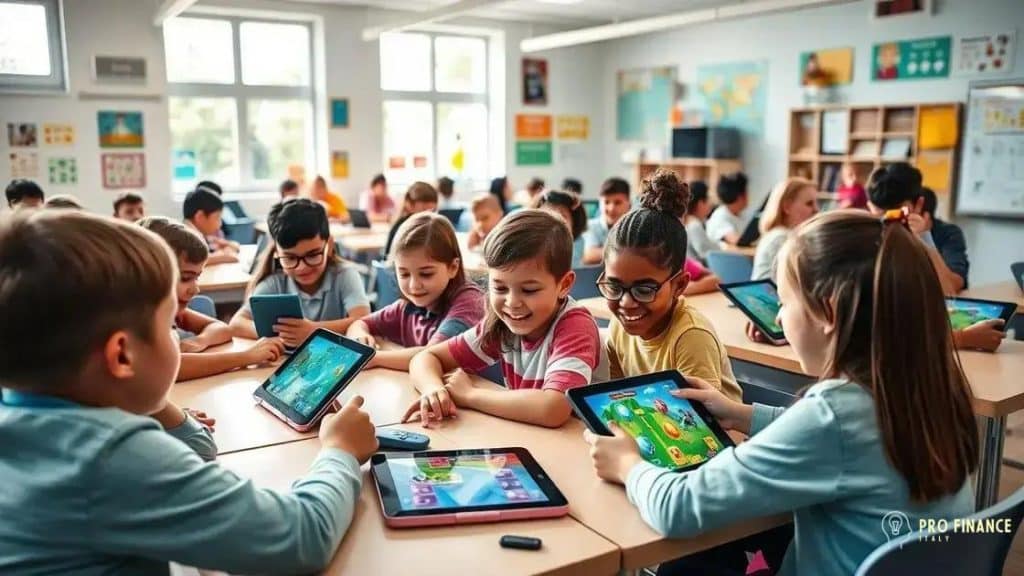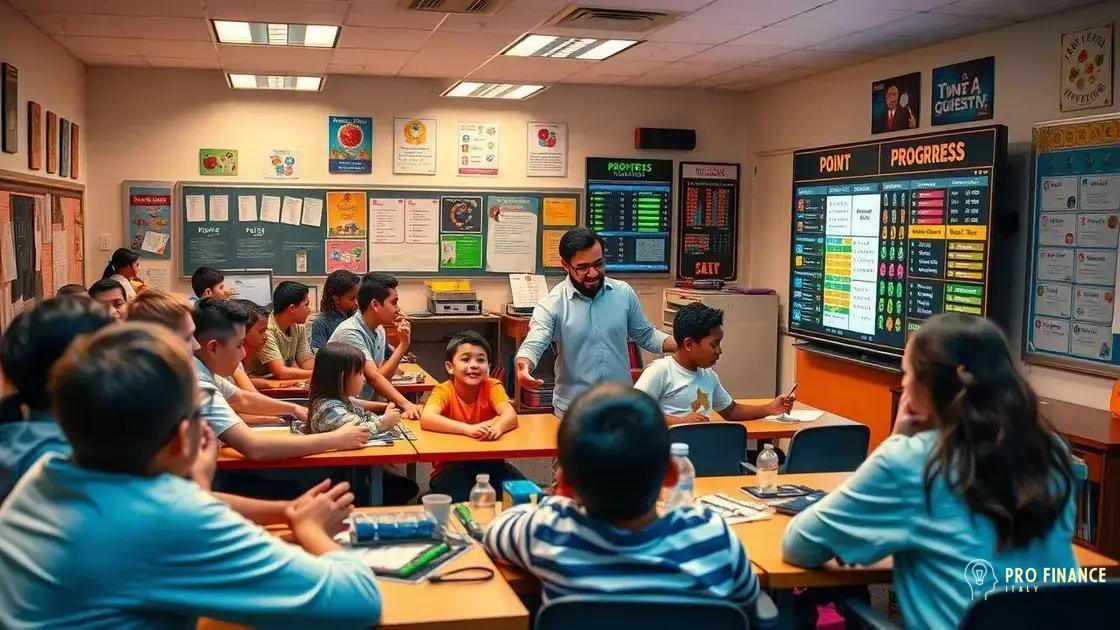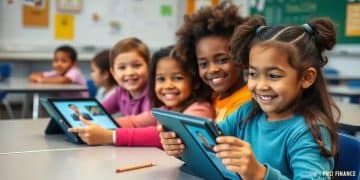The rise of gamified learning environments for K-12 students

The rise of gamified learning environments for K-12 students enhances engagement and motivation by incorporating game elements into education, making learning interactive and enjoyable.
The rise of gamified learning environments for K-12 students is reshaping how young learners engage with education. Imagine classrooms where students are motivated by game-based challenges instead of traditional lectures. Curious about how this transformation impacts learning?
What is gamified learning?
Gamified learning is an innovative approach that incorporates game elements into educational environments. It engages students in exciting ways that make learning more appealing. In this structure, students participate in activities that often involve challenges, rewards, and incentives, making the process of learning interactive and enjoyable.
Key Components of Gamified Learning
Several factors contribute to the effectiveness of gamified learning:
- Game Mechanics: Elements like points, levels, and badges turn learning into a game.
- Immediate Feedback: Students receive quick responses to their actions, helping them learn and improve.
- Goal-Oriented Tasks: Clear objectives motivate students to engage fully with their activities.
- Collaboration: Team-based challenges promote social interaction and teamwork among students.
By implementing these components, educators can create a memorable learning experience. For many K-12 students, gamification turns traditional subjects into adventures filled with fun and interaction.
Examples of Gamified Learning Environments
Many platforms and tools exemplify the success of gamified learning. For instance:
- Kahoot! allows students to take quizzes in various subjects, competing against peers for points.
- Classcraft transforms the classroom into a fantasy game, where students earn rewards for positive behavior.
- Duolingo uses game-like elements to help users learn new languages through engaging exercises.
These examples illustrate how engaging students through gamification can enhance their educational journeys. As students experience the thrill of progressing and earning rewards, their motivation to learn significantly increases, creating a dynamic educational atmosphere.
Benefits of gamified learning for K-12 students
The benefits of gamified learning for K-12 students are numerous and impactful. This approach transforms the educational experience by increasing engagement and motivation among students. When learning feels like a game, students are more likely to be active participants, leading to better retention of information.
Enhanced Engagement
One of the primary benefits is the enhanced engagement that gamified learning provides. Students become absorbed in the learning process as they tackle challenges and achieve goals. This makes learning exciting and helps sustain interest over time.
- Motivation: Gamification introduces rewards, encouraging students to push themselves further.
- Active Participation: Students take ownership of their learning, leading to better outcomes.
- Social Interaction: Many gamified platforms promote teamwork, allowing students to collaborate and learn from one another.
This increased engagement often translates to improved academic performance. Students are more likely to complete assignments and participate in discussions when they find the process enjoyable and rewarding.
Improved Learning Outcomes
Another significant benefit is the improvement in learning outcomes. Gamified learning can enhance critical thinking and problem-solving skills.
- Immediate Feedback: Students receive instant feedback, allowing them to understand their mistakes and correct them promptly.
- Peer Learning: Collaborative environments foster deeper understanding and retention through shared knowledge.
- Real-World Skills: Gamification often incorporates real-life scenarios, preparing students for challenges they might face outside the classroom.
As students engage in tasks that mimic real-world situations, they develop essential skills and confidence in their abilities.
Examples of gamified learning tools
Many gamified learning tools are available today, transforming how K-12 students learn and engage with educational content. These tools make learning dynamic and interactive, catering to different learning styles and preferences.
Kahoot!
Kahoot! is a popular tool that allows teachers to create quizzes, surveys, and trivia games. Students can participate using their devices, making learning fun and competitive. The instant feedback motivates students to improve their knowledge while enjoying the process.
- Interactive Quizzes: Encourages real-time engagement during lessons.
- Customization: Teachers can tailor content to fit their curriculum.
- Competition: Students enjoy competing with classmates, increasing motivation.
This tool not only enhances learning but also promotes teamwork and collaboration through group activities.
Classcraft
Classcraft gamifies the classroom experience by turning education into a role-playing game. Students can create characters and earn rewards based on their behavior and academic performance. This approach promotes positive interactions and accountability.
- Character Development: Students develop their characters as they progress.
- Collaboration: Teamwork is encouraged through group quests.
- Behavior Management: Rewards for positive actions encourage good behavior.
By integrating game elements with classroom dynamics, Classcraft fosters a unique and motivating environment for K-12 students.
Nearpod
Nearpod combines interactive lessons with gamified elements. Teachers can create engaging presentations that include quizzes, polls, and activities, allowing real-time student interaction.
- Interactive Lessons: Keeps students focused and involved during lessons.
- Assessment Tools: Instant assessments help track student understanding.
- Diverse Content: Supports various subjects and learning styles.
This tool enriches the learning experience by allowing students to participate actively and receive immediate feedback.
Integrating gamification into the curriculum

Integrating gamification into the curriculum can greatly enhance student engagement and learning outcomes. By embedding game mechanics into traditional lessons, educators can create a more stimulating environment that motivates students.
Steps for Integration
There are several steps teachers can take to successfully integrate gamification into their classrooms. First, it is important to identify the learning objectives and align game elements with these goals. By focusing on the desired outcomes, teachers can choose the right tools and activities.
- Choose Appropriate Tools: Select gamified applications that suit the subject and age group.
- Set Clear Goals: Define what students need to achieve through gamified activities.
- Create Team Activities: Encourage collaboration and competition among students.
By clearly defining the objectives, students will know what is expected of them and can engage more effectively in the learning process.
Designing Gamified Activities
When designing gamified activities, consider incorporating various game mechanics. Elements like points, levels, and badges can encourage students to progress and stay motivated. Teachers can create a point system where students earn rewards for completing tasks, participating in discussions, or helping peers.
- Progress Tracking: Use leaderboards to highlight top performers, fostering healthy competition.
- Real-World Scenarios: Design activities that mimic real-life situations to make lessons relevant and engaging.
- Student Input: Allow students to suggest themes or challenges that interest them.
This involvement not only makes learning more dynamic, but it also empowers students to take ownership of their education.
Feedback and Reflection
Integrating (gamification) also means providing continuous feedback. Regular assessments and reflections help students understand their strengths and areas for improvement. This feedback loop fosters a growth mindset, encouraging students to view challenges as opportunities to learn instead of setbacks.
When gamification is part of the curriculum, it can transform how students perceive learning. By feeling like players in an educational game, they become more invested in their success.
Challenges of implementing gamified learning
Implementing gamified learning in educational settings comes with its own set of challenges. While gamification can enhance engagement and motivation, educators often face obstacles that need to be overcome to achieve its full potential.
Technology Access
One of the primary challenges is ensuring that all students have access to the necessary technology. Not every student may have a device or internet connection, which can create disparities in learning experiences. Schools need to find ways to provide equitable access to technology for all students.
- Device Availability: Schools must ensure that there are enough devices for students who need them.
- Internet Connectivity: Adequate internet access is essential for online gamified platforms.
- Technical Support: Teachers may require training and resources to effectively implement gamified learning.
Addressing these issues is crucial to allow every student to benefit from gamified learning.
Resistance to Change
Another challenge is the resistance to change from both educators and students. Some teachers may be hesitant to incorporate new methods, feeling comfortable with traditional teaching practices. Additionally, students might struggle to adapt to a new way of learning.
- Teacher Training: Professional development is necessary to equip educators with the skills they need.
- Gradual Implementation: Introducing gamification step-by-step can help ease the transition.
- Student Engagement: It is important to involve students in the process to increase their acceptance.
Creating a supportive environment where teachers and students feel encouraged to step outside their comfort zones is essential for successful integration.
Balancing Game Elements
Additionally, finding the right balance between educational content and game elements can be challenging. If gamification becomes too focused on entertainment, important learning objectives may be overlooked. Educators must carefully design activities that are both fun and educational.
- Content Alignment: Ensure that game mechanics align with learning goals.
- Student Focus: Activities should promote meaningful learning rather than just competition.
- Feedback Mechanisms: Regular feedback helps maintain a focus on improvement.
By addressing these challenges, teachers can create effective gamified learning environments that enhance student learning and achievement.
In conclusion, integrating gamified learning into K-12 education offers many benefits. While there are challenges, such as technology access and resistance to change, the potential for enhanced engagement and improved learning outcomes makes it worthwhile. By balancing game elements with educational content, and ensuring that all students have the necessary resources, educators can create a dynamic learning environment. With the right approach, gamified learning can turn education into an enjoyable adventure for students.
FAQ – Frequently Asked Questions about Gamified Learning
What is gamified learning?
Gamified learning integrates game elements into the educational process, making learning fun and engaging for students.
What are the benefits of gamified learning?
Benefits include increased student engagement, improved motivation, and better retention of information.
What challenges can arise when implementing gamified learning?
Challenges include limited technology access, resistance to change from both educators and students, and finding the right balance between educational content and gaming.
How can teachers successfully integrate gamification into their curriculum?
Teachers can start by aligning gamified activities with learning objectives, choosing appropriate tools, and ensuring students have the necessary resources.





